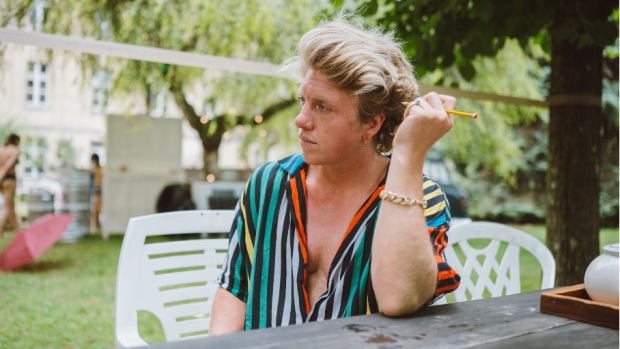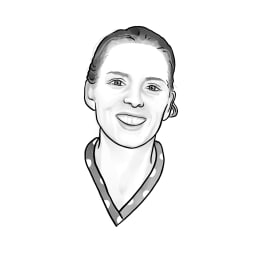
Simon(e) van Saarloos explored diversity in STEM fields as an artist
What is the state of diversity in STEM? Philosopher and UvA alumnus Simon(e) van Saarloos spent months as a guest in a physics laboratory and sees room for improvement. “It is quite reasonable to question one’s own convictions.”
While there are now slightly more women working at the University of Amsterdam, 60 per cent of those working in the sciences are still men. Philosopher Simon(e) van Saarloos spoke with staff at the Van 't Hoff Institute for Molecular Sciences (HIMS) about diversity and gives a lecture on the subject on Wednesday as part of HIMS Diversity Day.
For this lecture, Van Saarloos will draw on the experiences she gained while studying the daily lives of scientists at the prestigious Kavli Institute for Nanoscience at Delft University of Technology for three months. Surrounded by microscopes and quantum refrigerators, she was the institute’s first artist-in-residence and focused on the question: what should be present and, more importantly, what should not?
What was it like to dive into the world of science as a philosopher?
“Difficult and at the same time not difficult. It’s not actually strange for a philosopher to be involved in science: for a long time, science and the humanities were not separate. But at the Kavli Institute, I did feel that my presence was difficult.”
Simon(e) van Saarloos (1990) is a writer, philosopher, artist and curator. Van Saarloos was born in the United States, grew up in the Netherlands and studied philosophy and literary studies at the University of Amsterdam. They have written for various Dutch newspapers and authored several books, including Against Ageism - A Queer Manifesto in 2023.
At the time of writing, Van Saarloos is pursuing a PhD in rhetoric at the University of California, Berkeley. They are interested in the connection between black feminist philosophy and quantum mechanics and are writing their thesis on the rhetorical (im)possibility of existence without defence.
Simon(e) van Saarloos usually writes their name in brackets and prefers to be addressed as they or them.
“In my view, the natural sciences seem to have a certain superiority over the humanities. Whereas the humanities tend to see themselves as victims – funding is always being cut, there is less connection with industry – in natural science there is much less existential doubt about whether what you do matters. Even if you are really concerned with the smallest of the smallest tiny particles, the story is that you are indeed doing important work in a larger whole.
“In the natural sciences, an artist is often invited as a translator. The scientist explains how a complex process works, such as DNA replication, and the artist then translates that complex science into a mind map or painting for a wider audience. If I had been a musician, I would have made a sound game out of mycelium and turned it into music.”
“That wasn’t the role I wanted to take on. I wanted to investigate how the absence of things was present in the institute. How does absence touch us? I didn’t have a specific goal – which is very strange in an institute where everything is goal-oriented – and I wanted to see what would happen if I opened myself up to whatever came to me.”
And what came to you?
“Well, um... a lot, and a lot didn’t.”
“Science – as I know it as a human being – consists of a curiosity about things we don’t yet know. Scientists investigate that question based on what they already know. If we think from a feminist perspective: if the material we already know is quite hierarchical and based on a certain idea of what a human being is and what material is, then we reproduce what already exists. Even when we want to focus on what is still new and unknown.”

“One thing I discovered was the influence of gossip at the institute. Through gossip, I discovered what information was considered important and what information was considered unimportant. For example, ‘My experiment yielded this or that’ was important information, but everything that happened around it: what you had for breakfast that morning, whether you had an argument with that colleague, or had great sex, was not important. I started documenting the gossip and eventually turned it into an exhibition in the milk room.”
What was the gossip about?
“For example, about the physical complaints that some scientists had in the building. Those complaints were dismissed as unimportant: it were mainly complaints from women going through the menopause, yes, exactly. One employee kept track of her complaints for years and eventually succeeded in proving her right: it turned out to be a high level of low frequency noise. In a certain percentage of people, that can lead to headaches and sensitivity to light. Now there was a measurement, and it had to be true. That was interesting for me to follow: what is and isn’t allowed in an institute where curiosity is the driving force?”
You also spoke to HIMS employees about their experiences with diversity.
“That’s right, but I can’t say anything about that.”
What can you say about the state of diversity in science?
“Statistically speaking, you can of course say that women of colour or transgender people have less access to science than white men. But I advocate a different form of diversity. The fundamentals of how science is practised, or how an institute is structured, do not change significantly because of the players who enter it.”
“The architecture of a building also says something about diversity. I ended up hanging the gossip exhibition in a space that seemed the least visible to me: the lactation room. I had asked everyone for permission to use the space for the exhibition, with the message that expressing milk would always take precedence, and received no objections. But after just one day, complaints started coming in. Someone wrote: I don’t want anyone to know that I have to use the lactation room. I am here as a scientist, not as a mother.”
“Personally, I think that such an anecdote better illustrates for who there is room and for who isn’t, than numbers do. So there was someone who was a mother and a scientist, but who felt threatened by ‘coming out’ about her motherhood because it did not belong in science.’
How do you think that could be different?
“I’m not here to suggest how it should be done – I’m just raising the issue. Because I think that suggestions about how things should be always reproduce the status quo.”
Let me ask you another way: what do you hope this lecture will achieve?
“I would say my greatest ambition is quite small. Very specifically, by giving this lecture, I hope that there will be a number of people in the room who will experience a certain kind of recognition. And not in the sense of, oh hey, that’s a trans person too. Incidentally, I am white, middle class and, because of my transition, I am usually read as a man. So, of course, I myself am as undiverse as can be.”
“I mean recognition in the way of thinking, a playfulness in questioning and not really feeling at home with what is and isn’t present in science. And I don’t just mean in concrete terms: whether or not it’s okay to hang a Palestinian flag. But rather – I’m not going to tell my lab in the morning that I had really nice sex with a one-night stand that I’ll probably never see again. Because that doesn’t fit in with the institute.
“Incidentally, it’s not that I hope my lecture will encourage everyone to share all their sexual escapades at work; I’m not that goal-oriented, haha. But I do hope that there are people who recognise what is and isn’t welcome. And that there will be room for what seems unimportant in science.”
Do you think there could be more room for that in the future?
“Difficult. At the moment, it’s very difficult to be self-critical within science. The US is dealing with fascism, the Netherlands with the extreme right: they all want to make cuts – including on the natural sciences. Because of that pressure, faith in how science has been practised for years and decades is growing stronger. So no, I expect that faith in one’s own convictions will strengthen rather than weaken – even though they could certainly be questioned.”
On Wednesday 1 October at 3 p.m., Simon(e) van Saarloos will speak in Matrix One at Science Park. You can register here.


